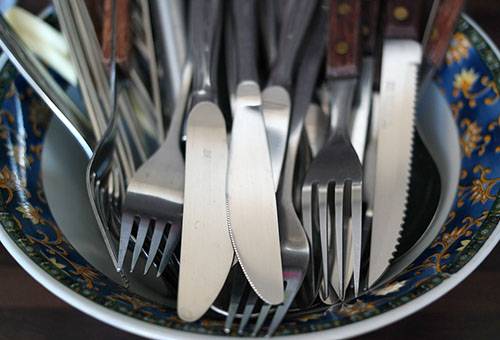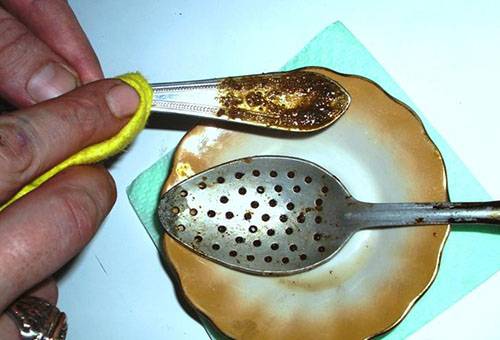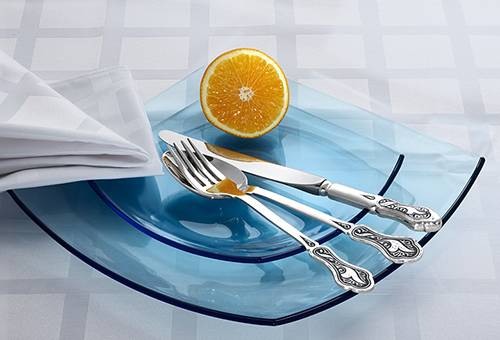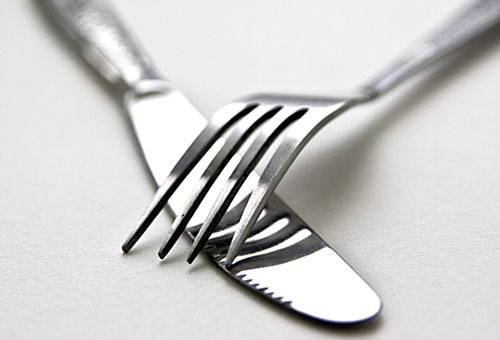How at home to clean the forks and spoons from stainless steel from plaque and dirt?
Although stainless steel is a fairly resistant material to the environment, it does not blacken as quickly and intensively as silver, but sooner or later the question arises of how to clean cutlery from this metal.
Timely washing of cutlery
Over time, fat on the surface of cutlery creates an unpleasant-looking dark coating, water with a high percentage of hardness salts and some food products lead to tarnishing of the metal.
Like any dishes, forks and spoons, it is important to regularly clean the remnants of food after eating using detergents and sponges for dishes. This will save you from having to wipe away dried and stubborn stains of unknown origin. In order not to damage the stainless steel coating, do not use abrasive products and hard brushes or washcloths.
Folk remedies
- As for silver, for products made of stainless steel, dentifrices are well suited - that is powders, that are pastes. Powder usually costs less, but the paste is more convenient due to its structure. However, the powder can be diluted with water to the consistency of sour cream, so that it would be more convenient to work. Anything can be a tool for cleaning - an old toothbrush, a rag, a sponge, etc.
- To give tableware shine at home, a very simple remedy is used - raw potatoes. It is cut into several pieces and rubbed with spoons and forks, which then need to be rinsed with water so that they do not leave a whitish coating and stains from starch. Instead of raw potatoes, you can use a potato broth - water in which the potatoes were cooked. In this liquid, the devices are soaked for a while or simply wiped with a cloth soaked in “broth”.
- Effective against a variety of contaminants on stainless steel mustard. A solution of it in warm water is used to clean dishes with a cloth, sponge or old toothbrush, which is especially convenient for hard-to-reach places, for example, between the teeth of a fork. You can also add baking soda to mustard.
- The coffee grounds are soft enough so as not to scratch the surface of the spoons and forks, but at the same time effectively wash even enough old dirt. There is no need to brew coffee specifically for these purposes: sleeping ground, remaining in a cup or a turk, is perfect.
- From tea plaque and mineral deposits on stainless steel appliances table vinegar, plain or apple, helps. A rag or sponge is moistened in it and the devices are wiped or the vinegar is dissolved in water and soaked there for a while. Instead of vinegar with the same result, you can use lemon, and in its absence, citric acid.
- Activated charcoal fights effectively with burnt or dried-up residues of milk and dairy products. A few tablets should be dissolved in a pan with water and lower the appliances there for 15-20 minutes.
- If there are a lot of devices, and there is not enough time to clean them, then you need to pick up a pot of water, add a tablespoon of salt and soda there and put the water to warm for 15-20 minutes. It is not necessary to bring it to a boil, but the temperature should be sufficiently high.
- How to clean spoons and forks in a summer house or picnic? For this, ash from a fire is suitable. It is effective not only for stainless steel appliances, but also for any utensils in principle.
Most of the folk remedies used to clean stainless steel are completely harmless to human health.But still, they are unpleasant in taste, so after removing contaminants, cutlery should be washed well with water.
Special tools
A rather aggressive, but effective means to return cutlery to cleanliness and shine, to remove any kind of plaque - “Domestos”. But it is necessary to work with this product with gloves, and then very carefully wash the spoons and forks, especially between the teeth and in various recesses, first with ordinary dishwashing detergent and then with running water so that there is no trace of Domestos. Instead, any similar product with a significant chlorine content can be used.
Of course, there are specialized compounds for cleaning dishes from a wide variety of metals, including stainless steel. When using them at home, it is important to carefully consider the information on the package and follow the instructions for use. But it should be understood that such tools are not omnipotent and rarely turn out to be much more effective than time-tested and also completely safe folk recipes.



